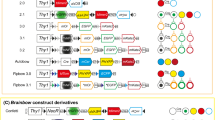Abstract
Cloned fragments of members of the Drosophila and mouse major heat shock (hsp70) gene family were used to demonstrate that homologous sequences are present in the rabbit genome. After a physiologically relevant increase in body temperature of 3°C, transcription of inducible hsp70 genes is detected in both the fetal and maternal brain and kidney. The induced hsp70 gene transcripts decay rapidly after whole body hyperthermia subsides. Transcripts of constitutively expressed member(s) of the hsp70 gene family, the heat shock cognate genes (hsc70), are detected in unstressed fetal and maternal rabbit tissues.
Similar content being viewed by others
References
Ashburner, M., andBonner, J. G. 1979. The induction of gene activity in Drosophila by heat shock. Cell 17:241–254.
Schlesinger, M. J., Ashburner, M., andTissieres, A., (eds.) 1982. Heat Shock: From Bacteria to Man. Cold Spring Harbor Laboratory, Cold Spring Harbor, N.Y.
Craig, E. A., Ingolia, T. D., andManseau, L. J. 1983. Expression of Drosophila heat-shock cognate genes during heat shock and development. Dev. Biol. 99:418–426.
Lowe, D. G., andMoran, L. A. 1984. Proteins related to the mouse L-cell major heat shock protein are synthesized in the absence of heat shock gene expression. Proc. Natl. Acad. Sci. USA 81:2317–2321.
Brown, I. R., Heikkila, J. J., andCosgrove, J. W. 1982. Analysis of protein synthesis in the mammalian brain using LSD and hyperthermia as experimental probes. In Molecular Approaches to Neurobiology, Academic Press, New York (I. R. Brown ed.) pp. 221–253.
Cosgrove, J. W., andBrown, I. R. 1983. Heat shock protein in mammalian brain and other organs after a physiologically relevant increase in body temperature induced by D-lysergic acid diethylamide. Proc. Natl. Acad. Sci. USA 80:569–573.
Southern, E. M. 1975. Detection of specific sequences among DNA fragments separated by gel electrophoresis. J. Mol. Biol. 98:503–517.
Moran, L. A., Chauvin, M., Kennedy, M. E., Korri, M., Lowe, D. G., Nicholson, R. C., andPerry, M. D. 1983. The major heat-shock protein gene family: related sequences in mouse, Drosophila, and yeast. Can. J. Biochem. and Cell Biol. 61:488–499.
Rigby, P. W. J., Dieckman, M., Rhodes, C., andBerg, P. 1977. Labeling deoxyribonucleic acid to high specific activity in vitro by nick translation with DNA polymerase I. J. Mol. Biol. 113:237–251.
Moran, L., Mirault, M.-E., Tissieres, A., Lis, J., Schedl, P., Artavanis-Tsakonas, S., andGehring, W. 1979. Physical map of two Drosophila melanogaster DNA segments containing sequences coding for the 70,000 dalton heat shock protein. Cell 17:1–8.
Wahl, G. M., Stern, M., andStark, G. R. 1979. Efficient transfer of large DNA fragments from agarose gels to diazobenzyloxymethyl-paper and rapid hybridization using dextran sulfate. Proc. Natl. Acad. Sci. USA 76:3683–3687.
Denhardt, D. T. 1966. A membrane-filter technique for the detection of complimentary DNA. Biochim. Biophys. Res. Commun. 23:641–646.
Chirgwin, J. M., Przybyla, A. E., MacDonald, R. J., andRutter, W. J. 1979. Isolation of biologically active ribonucleic acid from sources enriched in ribonuclease. Biochem. 18:5294–5299.
Lowe, D. G., Fulford, W. D., andMoran, L. A. 1983. Mouse and Drosophila genes encoding the major heat shock protein are highly conserved. Mol. Cell. Biol. 3:1540–1543.
Howley, P. M., Israel, M. A., Law, M.-F., andMartin, M. A. 1979. A rapid method for detecting and mapping homology between heterologous DNAs. J. Biol. Chem. 254:4876–4883.
Bardwell, J. C. A., andCraig, E. A. 1984. Major heat shock inducible gene of Drosophila and Escherichia coli heat-inducible dnaK gene are homologous. Proc. Natl. Acad. Sci. USA 81:848–852.
Ingolia, T. D., Slater, M. R., andCraig, E. A. 1982. Saccharomyces cerevisiae contains a complex multigene family related to the major heat shock-inducible gene of Drosophila. Mol. Cell. Biol. 2:1388–1398.
Ingolia, T. D., andCraig, E. A. 1982. Drosophila gene related to the major heat shockinducible gene is transcribed at normal temperatures and not induced by heat shock. Proc. Natl. Acad. Sci. USA 79:525–529.
Brown, I. R. 1983. Hyperthermia induces the synthesis of a heat shock protein by polysomes isolated from the fetal and neonatal mammalian brain. J. Neurochem., 40:1490–1493.
Clark, B. D., andBrown, I. R. 1985. Axonal transport of a heat shock protein in the rabbit visual system. Proc. Natl. Acad. Sci. USA 82:1281–1285.
Author information
Authors and Affiliations
Rights and permissions
About this article
Cite this article
Brown, I.R., Lowe, D.G. & Moran, L.A. Expression of heat shock genes in fetal and maternal rabbit brain. Neurochem Res 10, 1277–1284 (1985). https://doi.org/10.1007/BF00964846
Accepted:
Issue Date:
DOI: https://doi.org/10.1007/BF00964846




